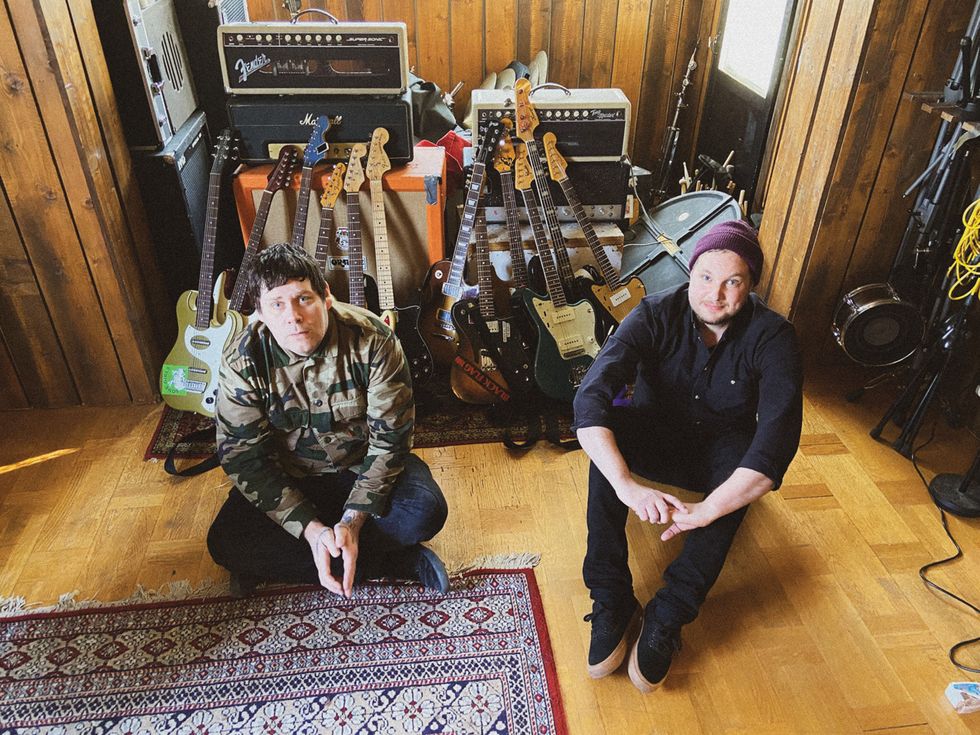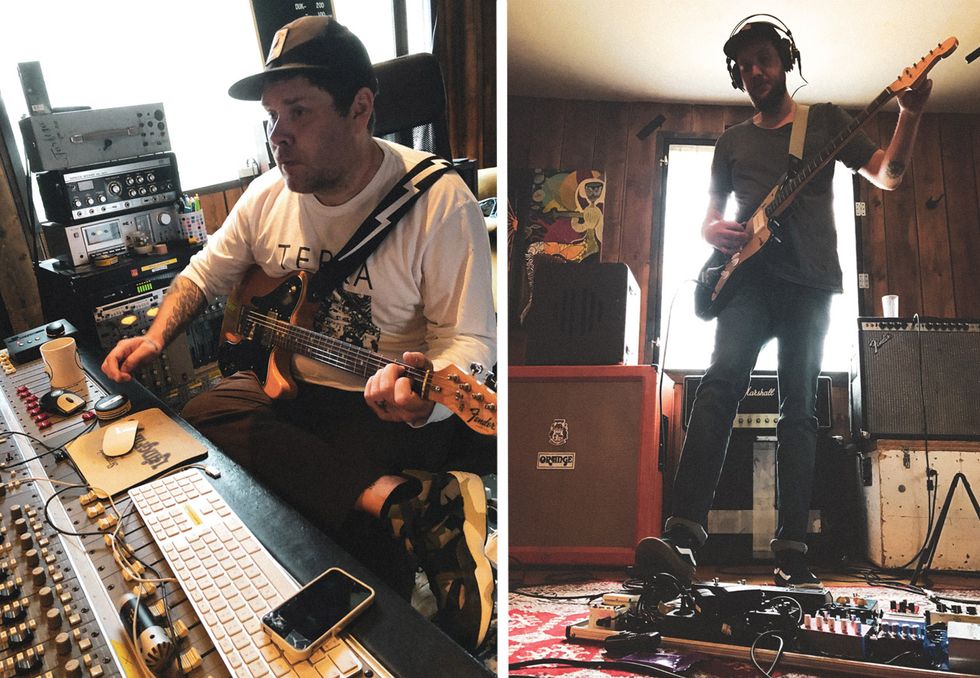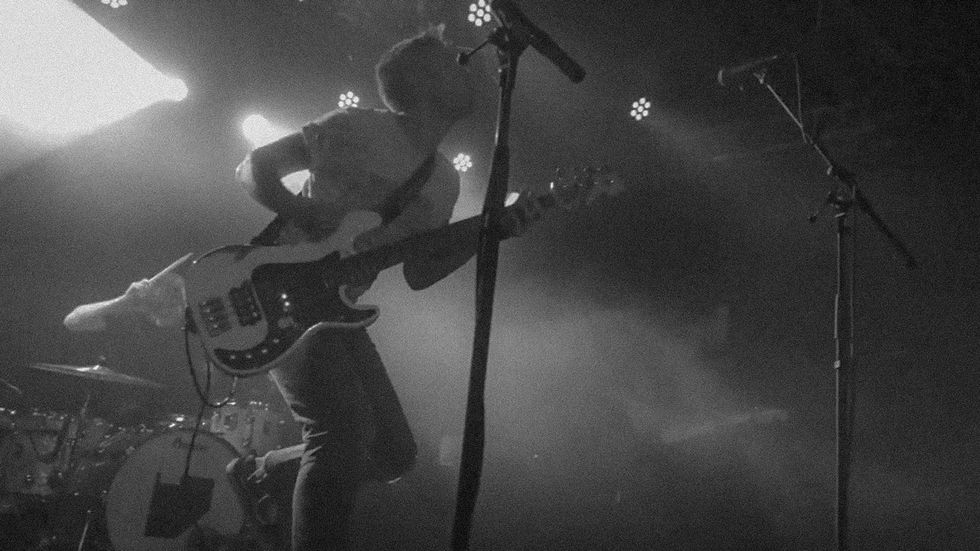A little over 15 years ago, an envelope from Bad Religion guitarist Brett Gurewitz’s Epitaph record label crossed my desk. Inside was a CD by a Swedish band I’d never heard of: Division of Laura Lee. The name made me think of those Sara Lee fruit pies you see in the freezer section.
With not-high expectations, I popped Das Not Compute into my drive and, as banal as it sounds, it marked the beginning of a musical turning point for me. Not because the music was necessarily pioneering, but because the unique mix of alternatingly careening and fuzzed-out garage-punk and melancholy shoegaze atmospherics was simply refreshing. For music journalists, the daily deluge of PR-hyped albums can jade you after a while. But Das Not Compute struck me as much for its raucous energy, moody textures, and cool guitar sounds as it did for its lack of affect and pretention—think My Bloody Valentine meets Sonic Youth’s more song-oriented side. I soon tracked down the quartet’s 2002 Black City (also on Epitaph), as well as a compilation of their straight-hardcore ’90s work, 97-99, and I’ve eagerly awaited every album since, from 2007’s Violence Is Timeless to 2013’s Tree and, finally, this year’s Apartment.
Why am I telling you this and thus committing my biggest journalistic pet peeve—inserting myself into a story that’s not about me? I guess it’s because so many of the people I’ve introduced Division to over the years have really dug them. “Why haven’t I heard of these guys before? They’re awesome!” To me, it’s a bit of a travesty they’re hardly known—especially after landing such a promising deal with one of the U.S.’s foremost proponents of punk and post-hardcore bands.
“It’s bittersweet in that it was the best of times,” says guitarist/vocalist Per Stålberg of the short-lived Epitaph deal and their time touring with influential post-hardcore outfit Thursday—which ended abruptly halfway through and saw DOLL heading back to Gothenburg. “We toured a lot and had a really good connection with those guys, but we did a lot of wrongs, too—we were snotty kids. I’m so proud of what we did, though, because we never compromised.” Asked to expound on the “compromise” bit, the still-avid skateboarder says it was “the typical manager thing. Like, ‘Dude, I broke my arm. I can’t tour.’ ‘Oh, well, let’s bring another guy on tour.’ ‘No! No, we wait.’ And we waited. Is that good for your career? Probably not, but honestly I don’t give a shit. I’d rather be me than somebody else. We would probably be bigger if we stuck on and did them, but we didn’t. We can’t change that now.” Adds cofounding bassist/vocalist Jonas Gustafsson, “I guess if we had made it a bit bigger, it would have struck way harder. I don’t think we would still be around now if we were famous for, like, 15 minutes and then lost it all.”
But Stålberg, Gustafsson, and founding drummer Håkan Johansson didn’t leave empty-handed, as the band’s stateside stint had seeded a lot of growth back home. “Violence Is Timeless did really good in Europe and especially in Sweden—which was the opposite of before,” Stålberg explains. “Except for the hardcore scene, nobody really cared about us in Sweden when we were touring the U.S.—or maybe that’s when they found out about us. But [the hardcore crowd] thought we sold out because we played too much [straight-ahead] rock all of the sudden.”
The first single from this year’s Apartment, a scathing brawler called “Hollow Pricks,” was released at the end of 2018. But otherwise it’s taken seven long years for Division of Laura Lee to produce the follow up to Tree. The big reasons for this include the fact that they lost longtime guitarist David Fransson, and each member, including Fransson’s replacement, Viktor Lager, now has kids, plays in other musical projects, and has a day job. (Stålberg operates Welfare Sounds studio in Gothenburg; Gustafsson, in addition to working in retail logistics, played in a TV talk-show house band; and Johansson works as a graphic designer.)
It wasn’t just that life was busy, though. The ambitiousness of their previous LP—they’d convinced themselves they needed to “mature” into something more sophisticated—had worn them out. “Tree was a big step to the left for Division … soundscaping and not so much riffing,” says Lager, the band’s newest member. “It was very hard to play live.” Gustafsson chimes in, “[On Tree] we were working with [producer] Jason Lytle from Grandaddy and we were aiming at something else. So when we started talking about the new album, I had one rule: no vocal harmonies!” Stålberg concurs: “It didn’t feel like we could write larger-than-life pop songs anymore—it felt really phony. We spent a lot of time talking about what the hell to do. Six to seven months after ‘Hollow Pricks’ was released, we knew we only wanted to do punk songs—like, really on-point and uncompromising: Here we are, take it or leave it. The rest of the songs came super fast and easy. Basically back to what we did in ’97, but we’re way better now.”
Then came the pandemic. Slated for a May 8 release in Europe, Apartment was delayed till August in hopes the global coronavirus situation might improve. In the meantime, in a move hearkening back to their DIY roots, DOLL both teased new tunes and revisited their deep catalog at an April 30 gig live-streamed from a Gothenburg drive-in theater. PG spoke to Stålberg, Gustafsson, and Lager a few days later.
Apartment was written long before COVID-19, but many of the lyrics seem inspired by the pandemic. “Safe” talks about “Someday you will be safe / I’ll be here, waiting for love / Take some time not worrying about your altered career and all of that B.S.” “Paris” talks about having to “fear for your life / The primal instinct to survive / Waiting for disaster / Stacking up supplies.” And the urgency of the title track’s—“I need to get out / Out of the apartment … I’m trying to survive / But I can’t get out”—feels like a coronavirus cabin-fever anthem.
Per Stålberg: I know, it’s insane. Especially “Apartment!” But we were actually done recording in May of last year. It just took forever to start with mixes. It was all mixed and mastered in December
Jonas Gustafsson: It’s mainly the lyrics that I wrote, as well—maybe I’d seen too much of The Walking Dead [laughs]. I try to imagine other peoples’ agony, because I’m quite a happy person. I grew up safe in a normal family, I’ve got some money saved up, and everything is fine, but we have a lot of friends who have been damaged by drugs and violence.
Stålberg: When you’re getting older, you can’t really write about how you had a tough time growing up, you know? But the world is still a weird place. Sometimes you feel cornered or alone, even if you have a cool family—and we all do. But sometimes that 18- or 20-year-old dude in you crawls out again and you feel like a weirdo, totally alone. That’s when it’s really easy to write lyrics, I guess.
“Hollow Pricks” feels like a brutal indictment of the mainstream music industry. “I need to wake up rich / And say bye, bye, bye, bye / You hollow pricks / ’Cause I’m DIY and I’m not yours to fix / I got my own plans, thoughts, ideas on how / To make us all be real and forever stay true.” What’s the story behind that?
Stålberg: It was inspired by a conversation I had with friends who said you can only do punk when you’re young. I felt they were all wrong. I don’t give a shit what you think—I haven’t wasted my life on punk rock. I would never believe that. It doesn’t matter who you are or how old you are. You can do whatever you want.
Stålberg and Lager with a stash of (mostly) Teles and Jazzmasters, and select old amps: Fender Super-Sonic and Tone Master heads (the current workhorses), as well as vintage Marshall and Laney boxes.
Jonas, you mentioned that, for Apartment, you had a strict rule against the sorts of vocal harmonies on Tree. Why?
Gustafsson: We do a lot of vocal harmonies in my other projects, but when it comes to Division of Laura Lee it sounds weird. I love when we mix our voices together—we’ve always done a lot of backup vocals—but usually just unisons or octaves. It’s funny though, because one of the first songs we recorded was “Safe,” which was written either during the Tree sessions or immediately after that.
That one and “Always Around” are definitely the mellowest ones on the album.
Gustafsson: Yeah, you can hear the bridge from Tree to Apartment—it’s those two songs. Aside from that it’s really rocking stuff. I like that. I can feel the energy and the desire that we had back in the day.
Stålberg: Viktor wrote that one [“Always Around”]. He sang it, too.
It has a mellow Sonic Youth vibe. What tuning did you use for that, Viktor?
Viktor Lager: It’s open-G—the lowest string is dropped-D, and then it’s G–D–G–B–D.
It’s interesting that the beautiful, melancholic vibe in “Always Around” is similar to older songs like “True Moon” [from Tree], “Breathe Breathe,” and “There’s a Last Time for Everything” [both from Das Not Compute].
Stålberg: I think so, too, because all those songs had different songwriters. “True Moon” was Jonas, and “Breathe Breathe” was David. It doesn’t really matter who writes the songs—when we play together, it sounds like Division.
Every Division album since the ’90s has had some amount of that DIY-punk vibe, but there was a huge shift between 1999’s [now-out-of-print] At the Royal Club and 2002’s Black City. What spawned that move toward more melody, instrumental nuance, and dynamics?
Stålberg: I think a couple of things. When we started the band, I was the oldest—I was 22—but Jonas and Henrik [Röstberg, original cofounding guitarist] were 17 or 18. So much shit happens when you start a band and start spending quality time with each other, talking about music. “Oh, you like that too?!” We’re proud to be from the hardcore scene, but it was not the only thing we listened to. Something that we took up a lot was our love for early shoegaze from England—My Bloody Valentine, the Jesus and Mary Chain—and also our love for bands like Hüsker Dü and Dinosaur Jr.
Stålberg (left) at the helm of his Welfare Sounds studio’s mixing console with one of his many Fender Telecasters. Lager (right) tracking Apartment at Welfare Sounds in Gothenburg with one of his go-to Fender Jazzmasters.
So we started sounding a bit different. We wanted to be a noise-rock band. Lyrically, we started to write different from hardcore—it was hard to stay in that vibe. It was way easier to go with a Stooges kind of vibe. And of course we grew. We played a lot, so we got better. We were tired of trying to write something that was already done. I’m not saying that we ever thought we were groundbreaking, but we wanted to be free in what we did.
Our friends Kalle [Gustafsson] and Don [Alstherberg], who produced Black City, did a lot for our sound, too. They took a lot of the melodies that we tried to hide, and they were like, “No, no, no—this is supposed to be up here, in front of the music.” They helped me and Jonas out on vocals. Like, “It doesn’t sound cool when you [only] scream. Just sing.” We were like, “Oh, okay.” We started using different guitars and different amps, keyboards, and all the weird things they had at Swedish Gramophone Studios [in Gothenburg] because of them, too.

Guitars
Circa-2000 Fender Tele Custom ’72
1978 Greco Les Paul Standard copy
Squier J Mascis Jazzmaster with Seymour Duncan Antiquity II pickups
Amps
Fender Super-Sonic combo
1960s Marshall 4x12 cab
Effects
Ibanez DL10 Delay
Ibanez Delay Champ
Boss RE-20 Space Echo
Way Huge Swollen Pickle
Fulltone OCD
MXR Micro Amp
Gollmer ’60s Trem
Strings and Picks
Ernie Ball Regular Slinky .010–.046 string sets
D’Addario NYXL .010–.046 string sets
Dunlop Ultex 1 mm picks

Guitars
Early-2000s Fender Jazzmaster
Fender American Original ’60s Jazzmaster
Amps
’90s Fender Tone Master head
Various cabs
Effects
Hamstead Soundworks Odyssey
Modified ’90s Pro Co RAT
Wampler Velvet Fuzz
Tru-Fi Colordriver
MXR Booster
MXR Carbon Copy Deluxe
Electro-Harmonix Oceans 11 Reverb
Electro-Harmonix POG
Strings and Picks
D’Addario NYXL .011–.049 sets
Dunlop Max Grip 1 mm picks
Gustafsson: Kalle was in Soundtrack of Our Lives, so he had a total different view on rock music. He brought in a lot of the stuff that they used to play around with when they were recording. Soit was a combination of getting a ton of instruments and amplifiers and all the magic that he had in the studio, and the fact that he was producing us in a way that we had never experienced before. The recordings we did earlier were like, “Yeah, you just do your thing.”
Stålberg: If we said to Kalle, “No, this song should be with some kind of drum machine and some old Moog keyboards,” he made that happen—and that made us change. Also in the beginning it was more about riffs and short songs … you just hit the guitar in somebody’s head, and it was over. We wrote a song called “The Truth Is Fucked” in late ’99 or early 2000, and that was a game changer for us. Before that, the songs all sounded pretty much the same, but this was something different. We all heard it. We were like, “Oh, hell yeah. Let’s do this.”
Speaking of gear, let’s talk about your go-to stuff these days, as well as how you captured tones for Apartment.
Stålberg: [Recording] is what I do on a daily basis, so when it comes to Division I know exactly what we need. We knew we wanted to strip down everything and focus on playing dirty noise-rock. So we did it like we used to back in the day: We were all in the same room in my studio—you could only hear the drums in that room, because we had the guitar cabs in other rooms. When we were finished, we listened to many takes. If something had to be fixed, we did it. Otherwise, we stuck with that. It was really easy. After we recorded the basic tracks with the whole band, we did the overdubs in a different studio, and they were just direct. Actually, it was into a [Roland] Space Echo, a preamp, then into the computer. That way it doesn’t sound as DI as it would if I only played through a preamp. The distortion was all from my pedals. The amp was pretty much the old Space Echo. We didn’t use much of its echo or reverb—we just put them through there for its basic sound.
What kind of mics did you use in the initial sessions?
Stålberg: Basically only a [Shure SM]57 on a cab, but sometimes I used Oktava ribbon mics for the room. They’re awesome—they sound kind of like a Royer. I put them about three feet back from the amp, maybe a bit more.
What about guitars?
Lager: I almost exclusively play Jazzmasters. That’s my favorite guitar. In the early 2000s I bought a Japanese Jazzmaster, plugged it in, and didn’t understand why it didn’t sound good! I was like, “What the fuck is this? The bridge is fucked up, and the pickups are bad and everything … but, it looks cool.”
What had you been playing before that?
Lager: Mainly my ’73 Telecaster Custom. I played the shit out of that guitar—it’s probably the best guitar I own. But I gravitated toward the Jazzmaster because of Sonic Youth and Dinosaur Jr. I was like, “How can they play like that with the trem and stuff?” I had to go online to the OffsetGuitars forum.
To figure out the setup tricks?
Lager: Exactly. I used the original bridge with Loctite [to secure the saddle-height screws] for a while, and then I changed to Mustang saddles, and that was okay. Then I bought the Staytrem bridge and tremolo unit, and swapped out the pickups for Seymour Duncan Antiquity IIs, and I was, like, “Okay, now we’re talking!” For me, the Jazzmaster neck pickup is the Jazzmaster sound, although not as much recently. I’ve actually gone more for the bridge pickup. I have the Mastery bridge on the new American Original ’60s Jazzmaster I bought like two months ago.
Bassist/vocalist Gustafsson onstage with his Sandberg California TM 4-string.
Which instruments did you lean on for Apartment, Jonas and Per?
Gustafsson: I have two Sandberg California basses. They sound so good!
Stålberg: I think I played three guitars, which is not much for Division. Sometimes we have different tunings and a bunch of different guitars. I think 70 percent was my Fender Tele Custom ’72. It’s a Mexican reissue from 2000, maybe. I changed everything you can change in it. It’s been broken everywhere, but it’s one of the best guitars I’ve ever played. It sounds super good. I also used a Greco Les Paul Standard copy from ’78, which is the best Les Paul[-style guitar] I’ve ever played. For the recording, I also bought a Squier J Mascis Jazzmaster and put Seymour Duncan Antiquity II pickups in it.
Per, most of the Teles you play have Wide Range-style humbuckers. Are those old Wide Range pickups or just whatever came in the guitar?
Stålberg: For a while, I had an old one. On this one, I don’t use the Wide Range [neck pickup] anymore. I only use the single-coil [bridge] pickup. It’s a Rio Grande, and it’s the best pickup for that guitar that I’ve ever heard. Back in the day on Black City, it was almost always the Wide Range pickups, though.
Which amps did you guys use during the initial sessions?
Stålberg: I used my Fender Super-Sonic 60-watt with an old Marshall cab from the ’60s.
Lager: I used an old ’90s, 100-watt Fender Tone Master head through a ’70s Marshall 4x12 that Per has. I only use the clean channel, and if you’re using a 4x12, it’s very clean. It’s like the biggest, fattest Fender you can get.
Gustafsson: Live, I’ve been using this TC Electronic RH750. It’s so light and handy, and it has this nice tube tone. I use that and a 4x10 Ampeg cabinet. In the studio, I go direct, but I completely rely on Per there. I just plug in and play.
How about effects?
Stålberg: I picked six pedals for the whole recording … pretty much the same that I’ve had for a long time with Division: an old Ibanez DL10 delay, another old Ibanez analog delay from the’80s called the Delay Champ. Then I have a Boss RE-20 Space Echo, and after that it’s a Way Huge Swollen Pickle fuzz, a Fulltone OCD, and an MXR Micro Amp. I think I had my Gollmer ’60s tremolo, as well. It’s from the ’90s. But I’ve seen them only in the Gothenburg area.

Basses
Sandberg California TT
Sandberg California TM
Fender Jaguar Bass
Amps
TC Electronic RH750 head
Ampeg 4x10 cab
Effects
Mooer Compressor
Electro-Harmonix Bass Blogger
Strings and Picks
Ernie Ball .045 string sets
Dunlop .73 mm picks
Lager: The overdrive I’ve been using a lot is a Hamstead Soundworks Odyssey. I also have a ’90s Pro Co RAT modified to original specs, and a Wampler Velvet Fuzz—I use the tight mode, because it has a great midrangey cut. That’s the main problem with a Big Muff—you don’t cut through. On a couple of songs, I used the Tru-Fi Colordriver as a fuzz. It’s based on the Colorsound Power Boost. I also have the MXR Booster and a Carbon Copy Deluxe. For the harmonized riffs in “Paris,” I used the Electro-Harmonix Oceans 11 Reverb, and on “Dodge Bullets,” I think there’s a[n EHX] POG with a delay.
Gustafsson: I like to try out pedals, but almost every time it ends up with me not using it. For Division of Laura Lee, I use a little Mooer compressor—I just turn it on and turn it up so I get a little distortion. Then I use an Electro-Harmonix Bass Blogger to just totally overdrive. It’s more for just making noise.
The core of Division—you, Jonas, and Håkan—has been together for nearly a quarter century. Do you have any advice for other guitarists on band longevity?
Stålberg: I’m lucky to know these guys. We all have other bands, but we were all aware that we were best together. We felt for a very long time that we had something that can’t be explained—I think a lot of bands do. But there are also a lot of managers and labels that confuse people into believing they’re bigger than each other. We were super nice and loved hanging out with people. We weren’t interested in boosting our egos. We don’t live off playing in Division of Laura Lee anymore—we did for a long time, but we just couldn’t do 200-plus gigs a year anymore. We had to tone it down. But the love is still there when we record and when we are in the practice room—it’s still the same feeling as it was in ’97. So my advice would be to just stick through it. We’re all different, and people are mean to each other sometimes, but it can all be worked out.
Written at the turn of the century, “The Truth Is Fucked” was a stylistic epiphany and major turning point for Division of Laura Lee.
“It was inspired by a conversation I had with friends who said you can only do punk when you’re young,” says Per Stålberg of “Hollow Pricks,” Apartment’s first single. “I felt they were all wrong … I haven’t wasted my life on punk rock.”
Division of Laura Lee revisits their deep catalog and teases new Apartment tracks during this April 30, 2020, performance live-streamed from a drive-in theater in Gothenburg, Sweden.












![Rig Rundown: Russian Circles’ Mike Sullivan [2025]](https://www.premierguitar.com/media-library/youtube.jpg?id=62303631&width=1245&height=700&quality=70&coordinates=0%2C0%2C0%2C0)















![Rig Rundown: AFI [2025]](https://www.premierguitar.com/media-library/youtube.jpg?id=62064741&width=1245&height=700&quality=70&coordinates=0%2C0%2C0%2C0)




















 Zach loves his Sovtek Mig 60 head, which he plays through a cab he built himself at a pipe-organ shop in Denver. Every glue joint is lined with thin leather for maximum air tightness, and it’s stocked with Celestion G12M Greenback speakers.
Zach loves his Sovtek Mig 60 head, which he plays through a cab he built himself at a pipe-organ shop in Denver. Every glue joint is lined with thin leather for maximum air tightness, and it’s stocked with Celestion G12M Greenback speakers.











